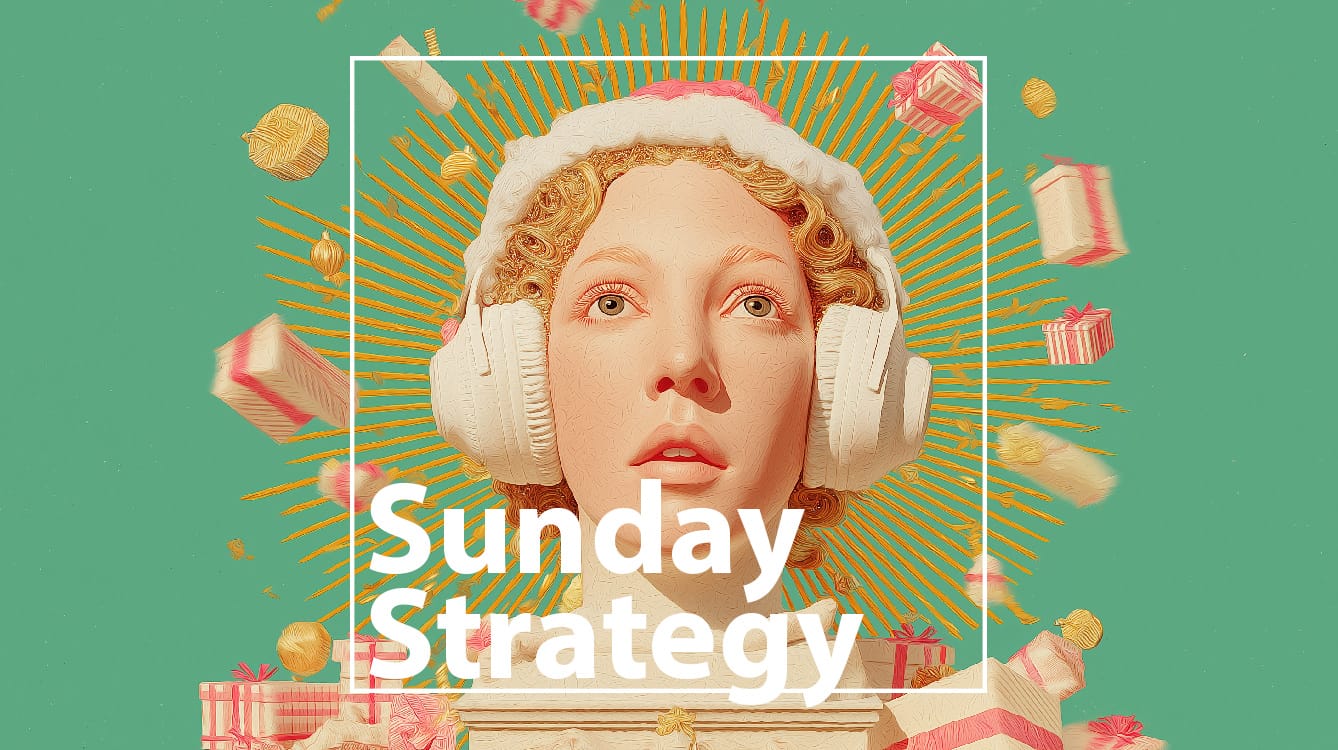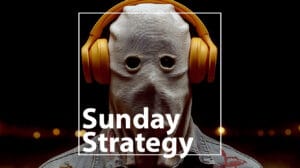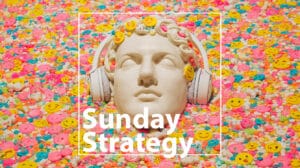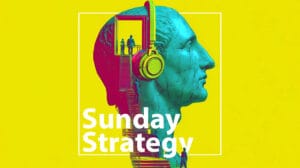In this issue of Sunday Strategy, we look at five stories to think about next week, including: Christmas Creep & Ad Wear-In, Repositioning a Food, How Delivery Changed Dining, Quantifying Set Lists and De-Skilling in AI.
In addition, we have ads from: IKEA, Bergdorf Goodman, Debenhams and SAS.
// Stories of the Week:
1.) Ready or Not, the Holidays Are Here.
As Mariah Carey officially lights the holiday ‘Beacons of Gondor’, the Christmas season is officially upon us. However, as brands try to tap into brisk holiday spending plans despite economic worries, and half of consumers reportedly want seasonal promotions before the end of October – Christmas advertising has already arrived. Ocean Spray, Amazon, Walmart, Sainsburys, Debenhams and others beat Ms. Carey to the holiday punch.
However, does an increasingly early start to the holiday season run the risk of holiday fatigue? What do Halloween, Guy Fawkes / Bonfire Night or Thanksgiving look like when later holidays pre-empt them? Does Christmas creep continue indefinitely or are we poised to see holiday resistance as some want to avoid an early start?
One interesting aspect of this year’s Christmas / Holiday ads isn’t just their early arrival, but the repeated use of certain characters and advertising. Amazon’s rerun of its previous ‘Joyride’ ad and Sainsbury’s reuse of Roald Dahl’s ‘BFG’ are two of a growing list of repeated advertising mechanisms. As a 2023 report showed, recurring holiday characters and ads created a compound effect with use, and as advertising has to run earlier and longer for the season – ‘holiday’ wear out fears may be regifted as intentional ‘wear-in’ for many marketers.
*Check out our growing list of over 1000+ Christmas ads from the 1980s to 2025 here.*
2.) How Do You Reposition a Food?
Ask Americans of a certain age about ‘The Other White Meat’ and many will say the classic tagline for Pork is up there with the Dairy Board’s “Got Milk”. However, what the campaign delivered in recall, it actually lacked in substance – as it positioned the food as a secondary choice and, in most cases, pork shouldn’t actually be white. So what do you do when your biggest asset doesn’t deliver what you need?
For the National Pork Board, follow up campaigns like ‘Taste What Pork Can Do’ have been an effort to combine correctness with cultural resonance, so far failing to meet the popularity of its greatest hit. It also highlights the challenge in branding a food category – where diner tastes and ‘product’ reality often have a natural tension that needs to be resolved.
3.) The Changing Nature of American Dining
As data from the National Restaurant Group claims that 3 out of 4 2024 restaurant orders weren’t eaten in a restaurant, it’s clear the impact that delivery apps and culture have made on dining. As ‘The Atlantic’ highlights, delivery has changed the flow of diners to food. Instead of diners coming into the restaurant for an experience, food is delivered out of the restaurant as a commodity. The shift, expanding from expected delivery fare to all but the most luxury restaurants has a knock on effect for what diners expect from eating out, when they do – as well as how restaurants plan, cook and deliver food.
The delivery channel creates a secondary customer for restaurants in delivery drivers and places the dining experience firmly in a third party’s hands. While the economics of delivery cut into restaurant profitability, the convenience it offers is hard to get customers to part with. We don’t look to be going back to how dining was before delivery or the pandemic, but barreling ahead to a future where the restaurant experience is delivery first and dine in second.
4.) What Happens When We Quantify Concert Set Lists?
To measure something is to fundamentally change it, something clearly seen with how setlist.fm has changed the live music experience. The website, purchased by Live Nation in 2010, holds sway over concert goers, helping to inform when to arrive and what to expect and artists, who use it to track performances and plan what to do next. However, does quantifying concert performances strip some of the unexpected magic out of the experience?
The tension between knowing and surprise or data and creativity goes wider than setlist, but it serves as a great example for how the tension intersects with our lives. As even our leisure time becomes more quantified, we’re increasingly optimising every aspect of our daily lives. When to arrive or leave a concert, what to expect or even if you should attend becomes a data driven decision through tools like setlist. What we gain in knowledge, we may be losing in organic discovery and artistic experience.
5.) How Bad is it to ‘De-Skill’?
As we worry about the impact of AI on education and basic skills, should we consider that all skills aren’t equally valuable? “De-Skilling”, or losing certain previously widely held skills, isn’t a new concept. Similar to the shift from oral communication to writing, when we lose certain skills – we often gain others. While we can’t lose essential skills, like ‘critical thought’ as we integrate AI assistance into our lives, we can be intentional about what we cognitively outsource and what it opens up in return.
// Ads You Might Have Missed:


1.) ‘Halloween Essentials’ – IKEA:
Halloween may have come and gone this weekend, but IKEA’s Halloween campaign shows how you can nail a clear, but unique, message about the holiday. The brand’s global work has tapped into different ways that its products interact with customers in their everyday lives, from infertility and grief to moments of celebration and even the beach. For Halloween in MENA, the brand takes the ‘hide behind the couch cushions’ sense of horror movies literally, showcasing ‘Halloween Essentials’, in the form of cushions, duvets and blankets that provide comfort while watching scary movies. The campaign’s simplicity is its beauty – showing that you can talk about Halloween authentically without a vampire costume or zombie in sight.
2.) ‘Proud to Serve the Toughest Crowd’ – SAS:
Can an ad celebrate how picky its customers are? Scandinavian airline SAS makes a virtue out of Scandi pickiness in its latest ad – using cultural attention to detail as a proof point for its high level of service. ‘Proud to Serve the Toughest Crowd’ uses Swedish American actor Joel Kinnaman, Rick Flagg from Suicide Squad, as a spokesperson to say that when Scandinavians travel, they naturally choose SAS. While national heritage is often used to prove commitment or skill, German auto manufacturers have dined out on perceptions for years, turning the focus to the customer’s national identity is less common. Perhaps there’s a fine line in calling customers positively refined vs. negatively picky – but SAS finds itself on the right side.
3.) ‘Christmas Delivered’ – Debenhams:
UK retailer Debenhams has launched their Christmas ad during Halloween and made a point out of its early arrival. As brands creep earlier with holiday launches, Debenham’s ad, a celebrity affair featuring Peter Crouch, Olivia Atwood and Judi Love, starts with a remark about how the season has ‘arrived already’. While the rest of the ad is expectedly tinsel tinged, featuring gifts, baubles and Christmas trees – the early start reflects the need to beat other retailers to holiday shoppers.
4.) ‘The Bergdorf Soiree’ – Bergdorf Goodman:
US department store Bergdorf Goodman’s holiday ad has also dropped early in the season, making a luxury meets Wes Anderson story of the invite to their holiday party the main focus. The “Bergdorf Soiree” features star author Linda Fargo, fashion designer Willy Chavarria, model Maggie Maurer, artist Cacho Falcon, filmmaker Quentin Jones, calligrapher Bernard Maisner and influencer sisters TK and Cipriana Quann in a series of vignettes that highlight different fashion pieces and moments. While the party itself isn’t shown, the ad stylishly highlights the preparation, arrivals and early morning departure of the affair. The stylishly quirky direction is engaging, but no matter how well done it is, is it too early to talk about the holiday party – when Thanksgiving dinner hasn’t even been purchased?
// Sunday Snippets
// Marketing & Advertising //
– Maserati jumps on the anti-AI ad bandwagon with an AI longing to actually drive a Maserati [Auto]
– IKEA USA launches a new brand platform with ‘Dream the Possibilities’ [Ads]
– Meta leans into print in India to launch their new Meta Ray-Bans as the source for answers [Tech]
– KFC Canada knocks out a few of the Colonel’s teeth to celebrate hockey season [Sports]
– Shutterstock reports that while creative spend is increasing, creative impact continues to decrease in advertising [Ads]
– UK electronic retailer Curry’s hops on the ‘my boss made me film this’ social media ad [Ads]
– How can software brand Grammarly rebrand in the age of AI? [Brands]
– WPP Media breaks down purchase journeys in their new report [Research]
// Technology & Media //
– Wharton’s 2025 GenAI adoption report shows enterprise use accelerating, but how companies think about AI changing [AI]
– Adobe announces Foundry, its GenAI resource to keep AI on brand [AI]
– Women and Gen Z are rewriting the art collection playbook, outspending men in recent Art Basel data [Art]
– OpenAI reveals a new cybersecurity agent, ‘Aardvark’ [AI]
– Uber and Nvidia announce a partnership to launch 100k robotaxis in 2027 [Travel]
– YouTube announces AI upscaling of ads for TV [AI]
– Pitchfork asks ‘Can Social Media Make you a Marxist’? Karl Marx unavailable for TikTok live stream to respond [Social Media]
– Google breaks down what type of content gets clicked on in AI overviews [AI]
– Pepsico has refreshed its masterbrand, jumping on the ‘tell people how to feel’ bandwagon [Branding]
– NEO’s home robot has launched for $20k and divided opinion [Tech]
– Stone Simulator, a game where you play as a rock, has added multiplayer [Gaming]
– Microsoft hints the next Xbox will run Windows and unify the gaming experience across platforms [Gaming]
// Life & Culture //
– A research deep dive into ‘Dupe Culture’ [Fashion]
– New research shows what we all inherently felt, emojis mean different things to different people [Research]
– Just in time for Halloween, the Guardian looks at the Hoia-Baciu forest, “The Bermuda Triangle of Transylvania” [Travel]
– Why are there so many skull logos on everything? [Culture]
– Canadian research shows parents concerns around the impact of social media on their kid’s spending [Finance]
– As marathon interest has grown (good luck to everyone currently running the NYC marathon by the way), marathon times have increased – shifting the race from pace to overall accomplishment [Sports]
– ‘Pumpkin Stylists’ are making a killing this autumn. Pumpkin spiced recession indicator? [Culture]
– ‘Its PR, not the ER’, how younger employees are resisting workplace emergency culture [Work]
// Until Next Sunday
As always, let me know what you think by email (dubose@newclassic.agency), website or on LinkedIn.
You can also listen to an audio summary and discussion of each week’s newsletter on Spotify. We’re also on TikTok!





